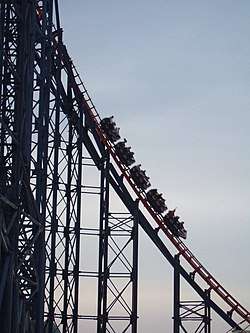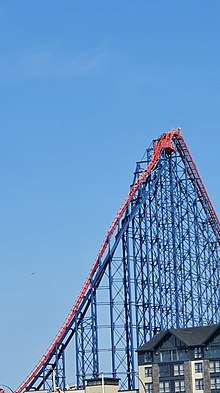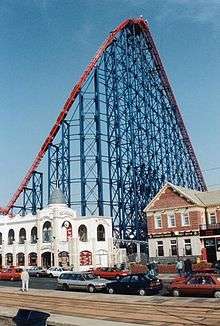The Big One (roller coaster)
The Big One, formerly known as the Pepsi Max Big One, is a steel roller coaster located at Blackpool Pleasure Beach in Blackpool, Lancashire, in the United Kingdom. Designed by Ron Toomer and manufactured by Arrow Dynamics, the ride opened to the public on 28 May 1994 as the tallest and steepest roller coaster in the world. It held the record until July 1996, when Fujiyama opened at Fuji-Q Highland in Japan. The ride is currently the tallest roller coaster in the United Kingdom.
| The Big One | |
|---|---|
| Previously known as Pepsi Max Big One (1994–2011) | |
 | |
| Blackpool Pleasure Beach | |
| Location | Blackpool Pleasure Beach |
| Coordinates | 53°47′21″N 3°03′19″W |
| Status | Operating |
| Opening date | 28 May 1994 |
| Cost | £12 million |
| General statistics | |
| Type | Steel |
| Manufacturer | Arrow Dynamics |
| Designer | Ron Toomer |
| Model | Hyper Coaster |
| Lift/launch system | Chain lift hill |
| Height | 213 ft (65 m) |
| Drop | 205 ft (62 m) |
| Length | 5,497 ft (1,675 m) |
| Speed | 74 mph (119 km/h) |
| Inversions | 0 |
| Duration | 3:00 |
| Max vertical angle | 65° |
| Capacity | 1,700 riders per hour |
| G-force | 3.5 |
| Height restriction | 52 in (132 cm) |
| Trains | 3 trains with 5 cars. Riders are arranged 2 across in 3 rows for a total of 30 riders per train. |
| The Big One at RCDB Pictures of The Big One at RCDB | |
History


The Big One's construction began in 1992 by Arrow Dynamics with Ron Toomer as its lead designer, and by the time it was completed, the total cost had reached £12 million.[1] The tubular track and supports were airlifted from Bolton to Blackpool and stored at nearby Blackpool Airport. During the start of the construction of the ride, the south of Blackpool promenade was closed and pieces of the structure were stored on the road adjacent to the Pleasure Beach. The first pieces to be fitted were the large foundations that would follow on from the main supports. Once all the supports were fitted, the tubular track was fitted followed by additional supports on the turnaround and the mid course brake section.
The roller coaster opened as the Pepsi Max Big One on 28 May 1994.[2] It was both the tallest and steepest roller coaster in the world when it debuted, but it was not the fastest.[3][note 1] The Big One's height record was surpassed by Fujiyama in July 1996, but it remains the tallest roller coaster in the UK as well as the country's second-fastest.[4][5][6] The Big One was also one of the longest, as its out-and-back roller coaster layout measures nearly a mile in length at 5,497 feet (1,675 m). Its top speed of 74 mph (119 km/h) in 1994 was second only to Steel Phantom at Kennywood, but it was the fastest coaster in Europe.[3]
The ride has maintained its sponsorship from Pepsi Max however the Pepsi Max branding was removed from the ride name in 2011[2]. The Pepsi Max pop can ride tunnel still remains as part of the ride.
Statistics
At its highest point, the ride reaches 235 feet (72 m) above sea level, but only stands 213 feet (65 m) above the ground with the first drop measuring 205 feet (62 m). These numbers were confirmed by Ron Toomer of Arrow Dynamics.[7] The first drop has an incline angle of 65 degrees and the usual maximum speed for the ride is 74 miles per hour (119 km/h). The ride lasts approximately three minutes and during this time riders normally experience positive g-forces of up to 3.5g and negative g-forces of up to 0.5g. Blackpool Pleasure Beach advertises the ride as rising 235 feet (72 m), but that is above sea level and not the actual height of the ride.
The ride is capable of running three trains at any one time, but usually only runs on 2 trains. Each train has five cars with six passengers to a car, enabling each train to carry 30 riders two-abreast in total. This gives the Big One a capacity of 1,700 people per hour. The colour scheme for each train is the same: a blue base with two coloured bands around the side and front (red and white) showing the Union Jack logo. Each train is numbered at the back of the fifth car, and each car is numbered according to the back of each section. During testing, sand bags are used to weigh the train down. This is a safety mechanism and is common practice on roller coasters of a certain height. Before the ride was granted a certificate to operate, Blackpool Pleasure Beach had to appeal to Blackpool Airport which is one mile from the park. Due to the ride's height, warning beacons had to be installed on the peaks of the first two hills, including the main drop, before the ride was given the all clear to operate.
Ride experience
Once riders are seated and secured, a siren sounds and the train exits the station down a small dip, turning 180 degrees straight into a tunnel decorated as a Pepsi Max pop can. After the brief tunnel, the train climbs the lift hill, which has height markers every 50 feet (15 m) showing riders the rising elevation, crossing over Icon's track. After reaching a height of 213 feet (65 m), the train drops 205 feet (62 m) after first entering a quarter right turn before rapidly descending a 65-degree drop. As the drop levels out, riders experience up to 3.5G and rise up a large hill with minimal airtime. The track bends slightly right into a large 180-degree, heavily-banked left turn followed by three slightly-banked airtime hills. After the third hill, the track crosses under Big Dipper and enters the mid-course brake run, before descending into a downward helix. The finale features an angled decline through Nickelodeon Streak into a tunnel – where the on-ride photo is taken – and a short ascent into the final brake run before returning to the station.
Incidents
In July 1994 during the ride's inaugural season, 26 people were injured when the computer system failed to completely stop a train returning to the station. The result of this brake failure was a collision with a train parked inside the ride's station. Another train collision occurred in August 2000, caused by another computer failure and injured 16 people.[8]
Notes
- Although not standing as tall as the Big One, Steel Phantom had a longer drop of 225 feet and therefore achieved greater speed.
References
- "Pepsi Max the Big One". COASTER-net. Retrieved 1 April 2018.
- Marden, Duane. "Big One (Blackpool Pleasure Beach)". Roller Coaster DataBase. Retrieved 1 April 2018.
- Hammond, Kip (1994). "Nevada Jackpot: The Numbers Game". RollerCoaster! Magazine. 16 (1): 12. ISSN 0896-7261.
- Marden, Duane. "Fujiyama (Fuji-Q Highland)". Roller Coaster DataBase. Retrieved 1 April 2018.
- "Record Holder - Height - UK". RCDB.com. Retrieved 1 April 2018.
- "Record Holder - Speed - UK". RCDB.com. Retrieved 1 April 2018.
- Hammond, Kip (1994). "Nevada Jackpot". RollerCoaster! Magazine. Chicago, Illinois: American Coaster Enthusiasts. 16 (1): 11–16. ISSN 0896-7261.
- Gray, Chris (2000-09-01). "20 hurt in crash on Blackpool rollercoaster". The Guardian. London. Retrieved 2016-06-26.
Roberts, J.M. (November 1, 1994). "The 'Pepsi Max Big One' rollercoaster - Blackpool Pleasure Beach". The Structural Engineer. Institution of Structural Engineers. 72 (21): 345–349.
External links
| Preceded by Magnum XL-200 |
World's Tallest Complete Circuit Roller Coaster May 1994 – July 1996 |
Succeeded by Fujiyama |